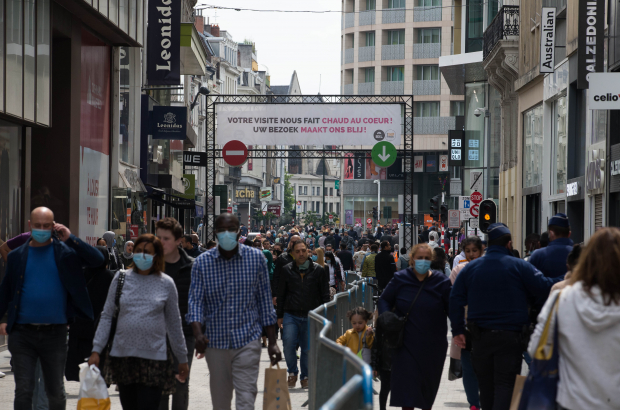- Daily & Weekly newsletters
- Buy & download The Bulletin
- Comment on our articles
New study shows three quarters of Brussels residents have foreign roots
Ten years ago, more than a third of the inhabitants of the Brussels region had a Belgian background, now it is a quarter, according to a report from Statbel, the Belgian statistics agency. The report shows that the capital is a melting pot of growing diversity.
In 2010, 36.2% of the inhabitants of the Brussels region had a Belgian background, compared with 25.7% in 2020. In 10 years, Brussels inhabitants with a foreign origin increased from two thirds to three-quarters of the population, according to Statbel.
The group of Brussels 'Belgo-Belgians' also fell in absolute terms: in 2010 they made up 394,000 of the 1.09 million inhabitants in the capital. By 2020, they totalled 313,000 out of 1.22 million inhabitants.
This is the first time that Statbel has mapped the origin of the Belgian population in this way, although the Brussels Institute of Statistics and Analysis (BISA) has done this before.
"Diversity in Belgium is increasing, and we wanted to map that out," said a Statbel spokesperson. "The demand for figures on this is constantly coming up, both from policymakers and from academia.”
“In this report, not only the current nationality has been considered, but also the first nationality with which residents, or at least one of their parents, recorded on the national register,” the spokesperson continued. "With this data, we get a much better picture of diversity and migration."
“If one of your parents was once registered as a non-Belgian, you officially have a foreign background,” the spokesperson added. “If it's the grandparents who immigrated and were naturalised, they won't be recorded.”
39% of Brussels residents are Belgian but, according to the definition used in this Statbel report, have foreign roots; another 35% only have a foreign passport. Together, they make up three-quarters of the population of Brussels.
"Brussels is the only region that is a big city, and in this respect, it is not comparable to Flanders and Wallonia," said Pascal Deboosere, demographer, and emeritus professor at the VUB university in Brussels. "If you compared the figures in Antwerp, Liège, or Charleroi, you would see a lot more similarities. Major cities are places you arrive in from abroad, and of course capitals are the hubs of international connections."
It was mainly in Brussels that migrant workers arrived between the 1950s and 1970s, and was the arrival point of the more recent, much more diverse immigrants from the 1990s onwards. The eastern enlargement of the European Union in 2004 and the many wars and conflicts around the world also led to new migration flows. "This includes well-known countries of origin, but also refugees who arrived more under the radar, from the small countries in the Caucasus, for example, such as Chechnya, Dagestan, Armenia or Georgia," said Professor Deboosere.
In addition, Deboosere refers to the European institutions, which provide direct and indirect employment for tens of thousands of international workers, and to the concentration of colleges and universities in Brussels. "In recent years, there has also been an additional active recruitment of foreign workers: for example, for our residential care centres, or computer specialists. Belgium reflects what is happening in countries worldwide with a well-functioning economy."
Deboosere calls the increase in the proportion of Brussels inhabitants with foreign origins compared to ten years ago a natural phenomenon: "It is like with the stock in a shop,” he said. “If that stock is constantly supplemented by a new product on the one hand and the old product continues to be sold on the other, then the share of the new product gradually increases."
There are also strong differences between the different municipalities in Brussels: while in central Brussels the number of inhabitants with a foreign background rises above 80%, in Watermaal-Bosvoorde, for example, it is only 47%.
The groups of foreign origin have been divided Statbel into neighbouring countries (which also includes the United Kingdom), MEMBER States of the EU27, and non-EU countries.
The Brussels region has the largest share of residents coming from a neighbouring country: approximately 10%. It also has the highest proportion of inhabitants with a national origin zone outside the EU27 zone, recorded as 45%. About 20% come from other EU countries.
The group of Brussels residents with a foreign origin can be further divided into a group without Belgian nationality, and a group of Belgians with a foreign origin - before they or their parents obtained Belgian nationality. Those groups are about the same size.
Residents of the region of foreign origin are on average much younger than residents of Belgian origin.
One in six of the people of Brussels with a foreign nationality was born in Belgium. Of the group of Belgians with a foreign origin, 62.3% or almost two-thirds were born in Belgium.
In general, Deboosere expects current trends to continue in our highly connected world. "People are increasingly moving to a different country rather than stay in their country of origin,” he said. “But you should not see this as a one-way street: hundreds of thousands of Belgians live all over the world."
The report shows that Flanders is significantly less diverse than Brussels and Wallonia: three out of four inhabitants are still 'Belgians with a Belgian background', almost the opposite ratio of those in Brussels.
The most diverse municipalities of Flanders are situated on the outskirts of Brussels: Machelen, Drogenbos, Vilvoorde, Kraainem and Zaventem. In a short period of time, these municipalities have changed considerably: 10 years ago, there were still more than 90% Belgians with Belgian backgrounds, now only just over 40%.



















